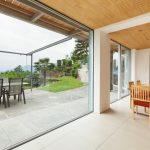At 10:00 a.m., the engines start running, the cables tense up and the wings open. The solar light slowly penetrates the building. Then, from above, the motors stop, the wings open to their full span, comparable to the wings of a Boeing 747. It’s as if the bird is going to take off at any time.
Under the bird, where the wings open, visitors lose themselves in the immensity of Lake Michigan, a genuine interior sea that flows by the eyes. Only large bay windows separate visitors from the waves that crash against the stone parapet. The building’s floor is almost at the same level as the surface of the lake.
Behind the visitors, at the other end of the interior space and beyond the door, a long walkway leads to Wisconsin Avenue, the city’s main artery. And the city is at about the same level as the lake. In other words, the lake is connected to the city through the building.
Inside the building, visitors file past works of art in intense light and whiteness. Everything is white: ceiling, walls, and floor.
At 5:00 p.m. the engines start up, cables move and the wings close. The solar light slowly leaves the inside of the building. After a minute, the engines fall silent, the wings are closed. The bird sleeps, folded over itself.
The wings adjust to weather conditions. Naturally they have sensors.
The bird is the Burke Brise Soleil. The building is the Quadracci pavilion of the Milwaukee Art Museum, in Milwaukee.
One museum curator, Russell Bowman, said that, when the wings of the bird open in the morning, he saw it as an invitation to the people of the city to come visit the museum.
The shape of the sunscreen has several interpretations. If the bird remains the most often used metaphor, some see it like a flower that opens. Others see a sailboat unfurling its sail before going on the lake. One author gives weight to this assumption by writing that the interior of the building resembles a ship’s mast.
 More down to earth people see a spine or a shell. What if it’s the fin of a shark? That’s not so far-fetched when you consider that one writer sees a shark skeleton running the length an interior gallery. Could the Quadracci pavilion be called “the great white shark?”
More down to earth people see a spine or a shell. What if it’s the fin of a shark? That’s not so far-fetched when you consider that one writer sees a shark skeleton running the length an interior gallery. Could the Quadracci pavilion be called “the great white shark?”
The Milwaukee Art Museum was no longer a museum like any other once the Quadracci pavilion was added in 2001. The people of the city quickly adopted the pavilion with its bird, a work of art in itself, as the symbol of Milwaukee. It also graces the cover page of a collectible book devoted to the Milwaukee Art Museum.
The pavilion and sunscreen are the work of Spanish architect-engineer Santiago Calatrava. The artist’s audacity allowed Milwaukee, a dark city that Americans ignored at the time, to embrace the new millennium with a renewed spirit by becoming a genuine tourist destination.
Calatrava said he chose white to make the structure lighter. Now there’s an argument that will please those who feel strongly about white as a decorating colour.
References:
Russell Bowman and Franz Schulze. Building a Masterpiece, Milwaukee Art Museum, Hudson Hills Press, New York, in association with Milwaukee Art Museum. 2001, 233 pages
Richard Weston. Les grandes idées qui ont révolutionné l’architecture, Dunod, Paris, 2013, 216 pages translation of 100 ideas that changed architecture, Laurence King Publishing Ltd (see page 132)
English Wikipedia article on the Milwaukee Art Museum
Photos: iStockphoto LP

